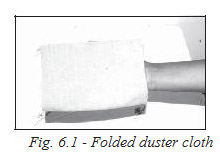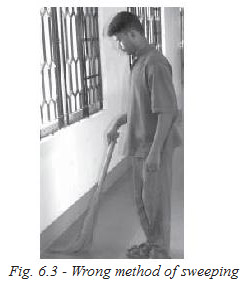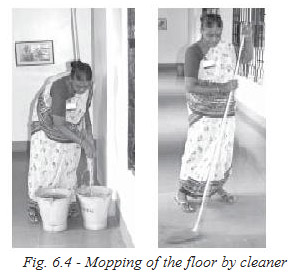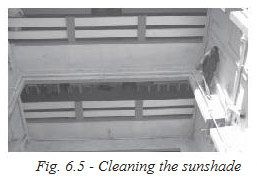Basic cleaning methods - part I
Dust can be airborne; one must remember the importance of removing dust rather than shifting dust from one place to another.
Dust can be removed by
- - Dusting: When a surface is dusted by rubbing, the electro-static charge caused by the friction attracts dust faster than before. Hence, as soon as the dusting is over, the dust rapidly settles on the surface again. Though frequently used, this method is not satisfactory. This activity needs to be carried out immediately after sweeping, and should be done with a wet duster, followed by a dry duster
- - Sweeping: Sweeping merely circulates the fine particles of dust into the air and is an unsatisfactory method. For this reason sweeping should be done just before dusting
- - Mopping: This is a fairly efficient method provided the mop is clean and the water is regularly changed during the cleaning process. However, most times the cleaner continues to use the same water, which is dirty, and does not care to wash the mop after the cleaning process. Thus the mopping done with dirty water and a greasy mop makes the whole exercise futile
- - Suction: This is probably the most efficient method of dust removal, as the dust is collected in a bag placed inside the vacuum cleaner. Once the bag is full, it can be disposed off
Dusting
In different areas of the hospital, especially in the patients’ rooms, on doors, windows, tables, chairs, cupboards, fans, lights and beds, dust settles down and this poses a health hazard as dust is a major cause for infection. Dusting is the process of removing this dust. To minimize the dust spread through the air, the housekeeper should have one or two treated dusters in hand . To properly treat a duster, fill a tray or pan with mineral oil and lightly place the duster in the tray to let it soak overnight. Care should be taken when treating a duster that it does not become greasy. The duster should be folded in 4, 8 or 16 folds, depending on the size of the duster, so that the cloth can be unfolded and refolded to prevent the same dusty side of the cloth from being re-used on different surfaces (Fig. 6.1).

Equipment and supplies
- - Duster - 2nos
- - Dry cloth
- - Cotton
- - Spirit
- - Water
Method of dusting
- - Collect all items required for dusting
- - Fold the duster so as to be able to dust a number of surfaces
- - Commence work from the entrance of the room and proceed in a clockwise direction
- - Start with the highest point to be dusted and work down towards the floor
- - Prevent overlapping and skipping edges. Hold the cloth loosely so that it can absorb dust easily
- - Do not shake the dust off the cloth
- - Inspect the work after it is done. A well dusted area will be bright and free of dust
- - After the work is complete, wash the duster and put it back in its place
Dusting a room
All rooms should be dusted daily. When dusting a room, the following points need to be remembered:
Doors and windows: When cleaning the door of a room, wipe the door with a wet duster from top to bottom in a left to right direction. Then wipe it again with a dry duster.
When wiping a window, the window frame, the glass panes and the frame around the glass panes, with all its corners should be wiped with a wet duster breadth- wise, and then again with a dry duster.
Tables, chairs, cupboards: The table top, its underside, drawers, and legs should be wiped with a dry duster. Similarly, a chair should also be wiped, starting with the backrest, the seat, under the seat, the legs, and the arms. All sides of a cupboard should be wiped daily, starting from the top. Then the inside of the cupboard should be cleaned thoroughly. The cobwebs should be removed, and the shelves should be cleaned. This should be done only in the absence of the patient.
Cots: The mattress should be dusted thoroughly. After folding the mattress, the cot should be wiped with a wet duster, and then thoroughly with a dry duster. If it is not wiped dry, the mattress will start to smell. Care should be taken to wipe the edges, the legs, and the underside of the cot.
Switchboards, lights, fans: Fans and lights should be dusted only after switching them off. This may be cleaned periodically, once a week. First they should be wiped with a wet duster and then with a dry duster. The switchboard should be wiped with spirit, and, if a wet cloth is used, there is a risk of an electric shock.
Other articles : The verandah balustrade, photos, and decorative articles in the room and other common places should be wiped daily.
Key points to remember
- - Always knock and politely ask permission before entering an occupied room
- - Fold the cloth into 4, 8 or 16 folds
- - The fold should be changed after dusting each surface
- - First wipe with a wet cloth and then with a dry cloth. By doing this, the dust will not fly about


Sweeping
Sweeping is a task that is carried out daily. People are always moving about in all the areas and rooms of the hospital. Their footwear brings in mud and dust particles from the outside. Sweeping is the process to remove this dust and dirt by using a brush or a broom. Sweeping is always done before mopping. The frequency of sweeping depends on the amount of traffic and the type of service. The out-patient section, in-patient section, and registration are the areas with maximum movement of people. Hence these areas should be cleaned several times a day (Fig. 6.2 & Fig. 6.3).
The wards should be swept twice a day. The office and administrative areas of the hospital should be dusted and swept after working hours.
Equipment and supplies
- - Soft broom
- - Dust pan
- - Dust bin
Selecting the equipment
- -The brush of the broom should be long and dense
- -Do not use a broken dust bin or a broken dust pan
Method of sweeping a patient’s room
- - Before entering the room for cleaning, keep all the required materials ready
- - Enter the room only after knocking and getting the patient’s permission to clean
- - Switch off the fan
- - If the room is dark, switch on the light
- - Look around the room
- - Handpick the solid waste lying around on the floor and put it in the dust bin before starting to sweep
- - Keep the windows wide open
- - Latch the doors and windows to avoid them from banging
- - Do not shake the dust from the doormat in front of the patient. Take it to a corner of the room, bend and dust it thoroughly
- - Bend and sweep the room thoroughly, including all the edges and corners
- - After sweeping the room, put the doormat in its place
- - Do not drag the tables and chairs. The sound will disturb the patient, and moreover, dragging furniture will create scratches that will collect additional dust
- - Every nook of the room, including under the cupboard, under the cot and area behind the doors should be swept thoroughly
- - The dust collected from the room should be swept outside and piled against the wall
- - After sweeping the room the dust should immediately be collected into a dustpan and put into the dustbin
- - Switch the fan back on and thank the patient for the co-operation
- - All areas of the hospital should be swept in the same manner.
- - After sweeping, store the broom, pan and dustbin in their allotted place
Key points to remember
- - The articles removed from the patient’s room to facilitate cleaning, should be put back in their respective places after the cleaning is complete.
- - While sweeping, the person should bend and use the broom, in order to sweep thoroughly.
Mopping
To disinfect all the areas of the hospital, we need to mop with a mixture of clean water and an anti- microbe disinfectant. Mopping will also remove any dust that remains after sweeping, and any stains on the floor. This is a routine task.
Equipment and supplies
- - 2 Buckets
- - Water
- - Disinfectant
- - Mop
It is wrong to carry two full buckets of water in one hand.
Two buckets filled with water should be carried separately in each hand.
Method of mopping the patient’s room
- - Mop only after the room has been thoroughly swept
- - The mop should always be clean or else it will stain the floor
- - Before mopping, all the required materials should be at hand
- - Depending on how dirty the mopping area is, divide the room into imaginary portions
- - Fill two-thirds of one bucket with water mixed with detergent, and two-thirds of the other bucket with plain and clean water.
- - Place both the buckets on a mat to prevent staining of the floor
- - Set aside light furniture to clean the floor well.
- - Rinse the mop in clean water, dip it in the bucket containing the detergent, squeeze it well, and then mop
- - Mop by drawing a figure “S” from left to right
- - After mopping each small portion, rinse the mop in clean water, and repeat the process (Fig. 6.4)

- - If the water becomes dirty, replace it with clean water
- - The dirty water should be poured directly into the bathroom outlet, otherwise the dirty water may stagnate and cause floor stains
- - Inspect the work. A well-mopped floor should have a clean surface. The corners should be clean and the floor should have no watermarks
- - After completing the work, wash the mop thoroughly and dry it in the sun. A wet mop breeds bacteria
Key points to remember
- - Before mopping check whether the mop is clean and dry
- - Divide the room into small portions. Thoroughly rinse the mop after each portion and dip the mop in detergent before beginning a new portion
- - The dirty water should be poured directly into the bathroom outlet
Scrubbing
Scrubbing is done on surfaces that are extremely dirty. More water is needed for scrubbing than for mopping. This activity is carried out whenever necessary.
Equipment and supplies
- - 2 Buckets
- - 2 Mops
- - Brush with a long handle
- - Cleaning agent
Method of scrubbing a floor
- - First, sweep the area to be scrubbed, and then dampen it with water
- - Sprinkle/spray the cleaning agent on the damp area
- - Start scrubbing, using the long handled brush. If the whole room needs to be scrubbed, start from the far corner and move towards the door. If a small area, start scrubbing from the outer area and end at the center, to avoid spreading dirt. If the stain is stubborn use steel wool
- - Remove the dirty solution using a mop
- - Dipthesecondmopincleanwaterandmopthefloor
- - Repeat the scrubbing and mopping process until all the dirt is removed
- - Inspect the area. A well-scrubbed area should look clean and dry
- - Cleanalltheequipmentandstorethembackinplace
Washing
Washing of floors is done to remove the soil and dirt brought in from the outside with the use of water. Sometimes scouring powder is used to remove tough stains. Walls are washed at least once a month to ensure that they remain clean and stain free. Wash as often as necessary to maintain cleanliness and hygiene.
Equipment and supplies
- - 2 Containers
- - Cleaning agent
- - Sponge
- - 2 Swabbing cloths
- - A ladder to reach high places
Method for washing
- - Fill one container with a cleaning agent and the second container with water. Place them on a mat to prevent staining
- - Wipe away loose earth from the area to be cleaned.
- - Dip the sponge in the cleaning solution. Squeeze out the excess solution to prevent dripping
- - Apply the solution on a small area using a circular motion
- - Dip a cloth in the clean water and wash the area using an up-down motion
- - Dry the area with a dry cloth
- - Repeat the process until the entire area has been cleaned
- - Change the water and solution frequently
- - Inspect the work. A well-washed area will have no scratches or patches
- - Clean the equipment and store them back in place
Cleaning the surroundings
Cleaning the surroundings means maintaining the cleanliness and hygiene at the hospital entrance, around the hospital building and the area surrounding the hospital compound. This is a daily activity. (Fig.6.5).
The entrance is the face of the hospital and should be spotless to make a positive impression on the visitors.
Since the entrance has the most human traffic, it needs to be swept frequently. Visitors may throw away bus tickets; cigarette butts, paper scrap, plastic bags, and flowers on the path leading to the hospital. Housekeepers assigned to the out-patient section

should regularly check for waste lying at the entrance and remove it immediately. A dustbin with the caption “please put waste in the dust bin” should be placed at the entrance.
The area outside the hospital compound should be swept daily and the waste should be removed immediately. The night shift workers should then dispose this off.
The parking area in front of the entrance should be checked regularly for diesel and oil stains caused by vehicles. These should be removed immediately, by scrubbing using a scouring powder, otherwise they form stubborn stains.
Waste thrown out of the windows by the patients and visitors accumulates on the ground and windowsills, creating an unseemly look clogging the drains during the rainy season.The fringes and backyard of the hospital building should also look tidy. The dry leaves and litter should be swept away and the windowsills, sunshades and outer walls of the hospital should be swept daily and washed once a week.
Maintaining cleanliness and hygiene in the area surrounding the hospital is as important as maintaining the interior.
Student exercise
Answer the following
- What are the different ways of keeping the hospital premises clean?
- Under what conditions are scrubbing and washing preferred to ordinary sweeping and mopping?
- Write a detailed note on how you would dust a patient’s room
- How would you sweep a patient’s room?
- Why do we mop after sweeping? How is this done?





